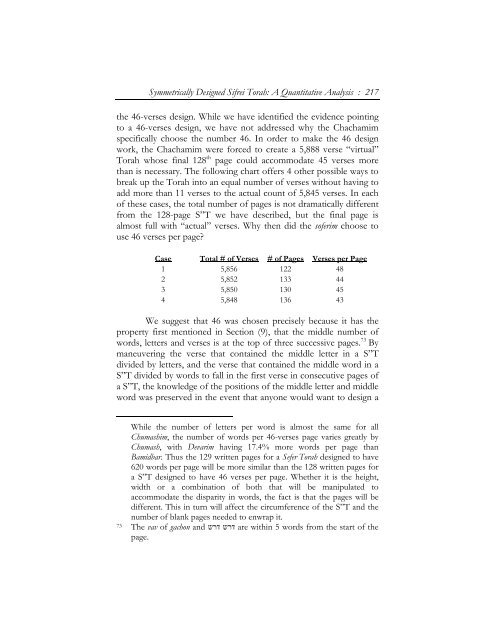Symmetrically Designed Sifrei Torah: A Quantitative Analysis - Hakirah
Symmetrically Designed Sifrei Torah: A Quantitative Analysis - Hakirah
Symmetrically Designed Sifrei Torah: A Quantitative Analysis - Hakirah
You also want an ePaper? Increase the reach of your titles
YUMPU automatically turns print PDFs into web optimized ePapers that Google loves.
<strong>Symmetrically</strong> <strong>Designed</strong> <strong>Sifrei</strong> <strong>Torah</strong>: A <strong>Quantitative</strong> <strong>Analysis</strong> : 217<br />
the 46-verses design. While we have identified the evidence pointing<br />
to a 46-verses design, we have not addressed why the Chachamim<br />
specifically choose the number 46. In order to make the 46 design<br />
work, the Chachamim were forced to create a 5,888 verse “virtual”<br />
<strong>Torah</strong> whose final 128 th page could accommodate 45 verses more<br />
than is necessary. The following chart offers 4 other possible ways to<br />
break up the <strong>Torah</strong> into an equal number of verses without having to<br />
add more than 11 verses to the actual count of 5,845 verses. In each<br />
of these cases, the total number of pages is not dramatically different<br />
from the 128-page S”T we have described, but the final page is<br />
almost full with “actual” verses. Why then did the soferim choose to<br />
use 46 verses per page?<br />
Case Total # of Verses # of Pages Verses per Page<br />
1 5,856 122 48<br />
2 5,852 133 44<br />
3 5,850 130 45<br />
4 5,848 136 43<br />
We suggest that 46 was chosen precisely because it has the<br />
property first mentioned in Section (9), that the middle number of<br />
words, letters and verses is at the top of three successive pages. 73 By<br />
maneuvering the verse that contained the middle letter in a S”T<br />
divided by letters, and the verse that contained the middle word in a<br />
S”T divided by words to fall in the first verse in consecutive pages of<br />
a S”T, the knowledge of the positions of the middle letter and middle<br />
word was preserved in the event that anyone would want to design a<br />
While the number of letters per word is almost the same for all<br />
Chumashim, the number of words per 46-verses page varies greatly by<br />
Chumash, with Devarim having 17.4% more words per page than<br />
Bamidbar. Thus the 129 written pages for a Sefer <strong>Torah</strong> designed to have<br />
620 words per page will be more similar than the 128 written pages for<br />
a S”T designed to have 46 verses per page. Whether it is the height,<br />
width or a combination of both that will be manipulated to<br />
accommodate the disparity in words, the fact is that the pages will be<br />
different. This in turn will affect the circumference of the S”T and the<br />
number of blank pages needed to enwrap it.<br />
73 The vav of gachon and דרש דרש are within 5 words from the start of the<br />
page.
















